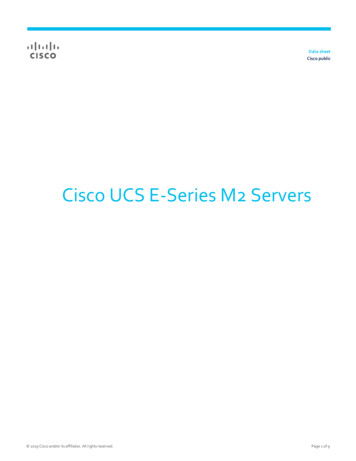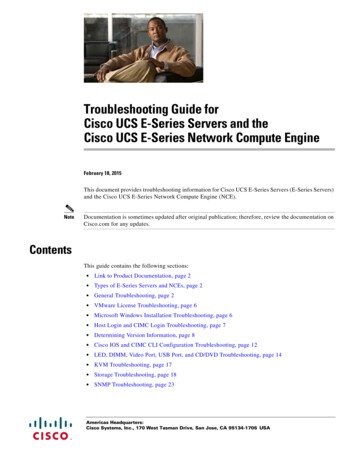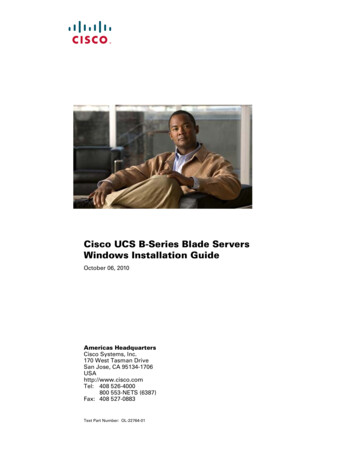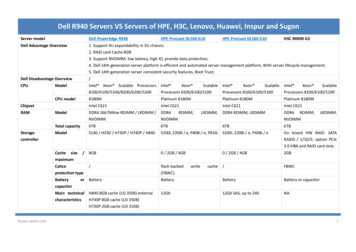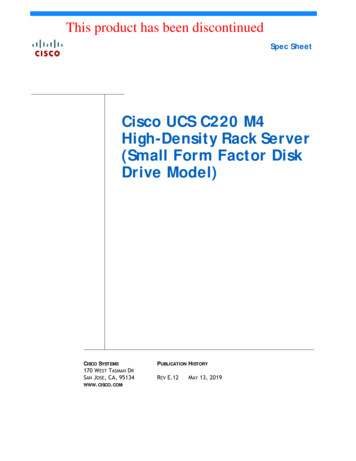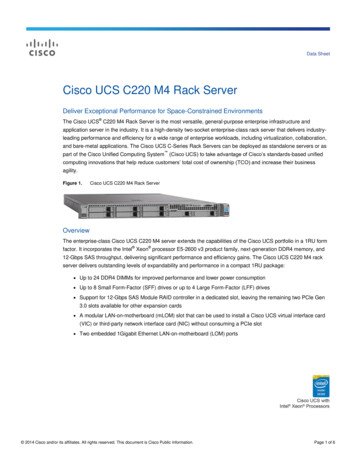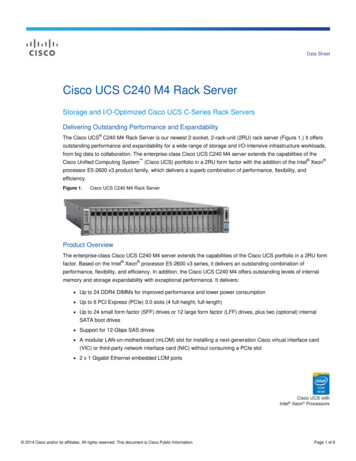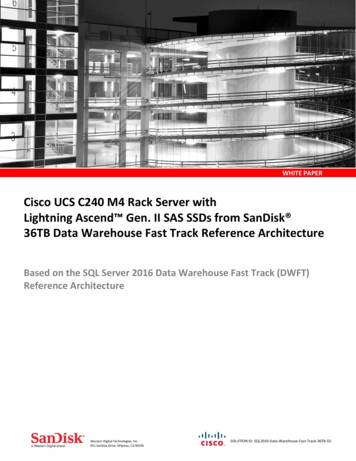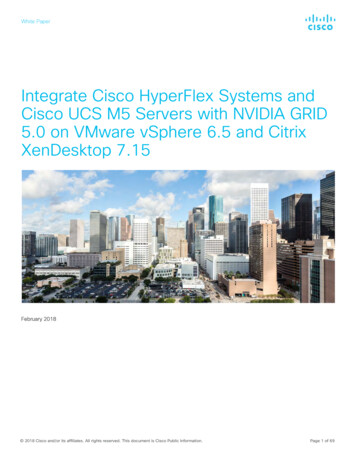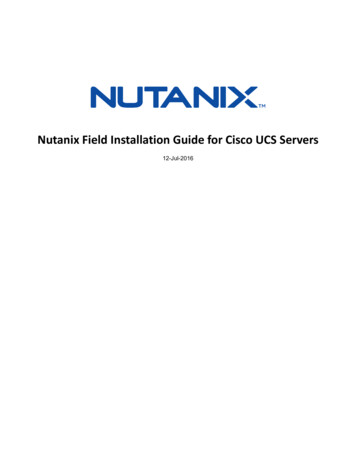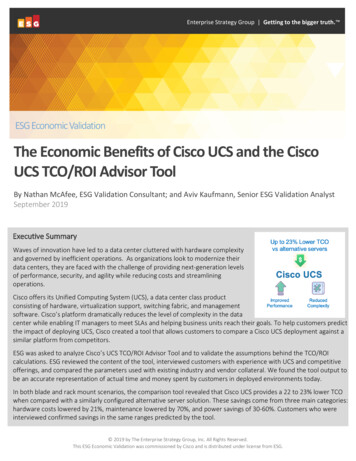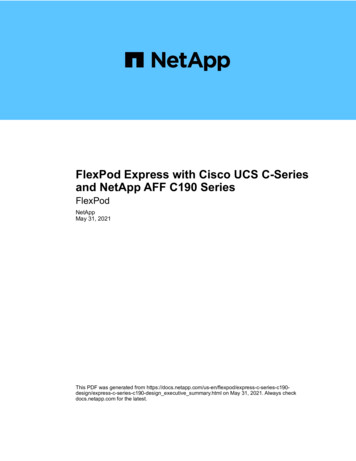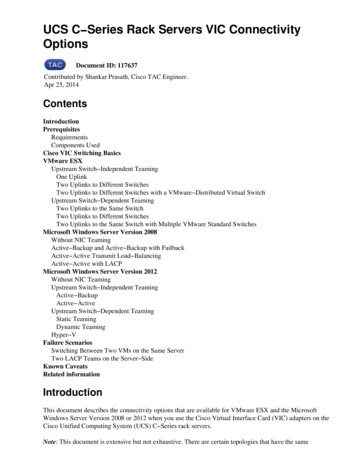
Transcription
UCS C Series Rack Servers VIC ConnectivityOptionsDocument ID: 117637Contributed by Shankar Prasath, Cisco TAC Engineer.Apr 25, omponents UsedCisco VIC Switching BasicsVMware ESXUpstream Switch Independent TeamingOne UplinkTwo Uplinks to Different SwitchesTwo Uplinks to Different Switches with a VMware Distributed Virtual SwitchUpstream Switch Dependent TeamingTwo Uplinks to the Same SwitchTwo Uplinks to Different SwitchesTwo Uplinks to the Same Switch with Multiple VMware Standard SwitchesMicrosoft Windows Server Version 2008Without NIC TeamingActive Backup and Active Backup with FailbackActive Active Transmit Load BalancingActive Active with LACPMicrosoft Windows Server Version 2012Without NIC TeamingUpstream Switch Independent TeamingActive BackupActive ActiveUpstream Switch Dependent TeamingStatic TeamingDynamic TeamingHyper VFailure ScenariosSwitching Between Two VMs on the Same ServerTwo LACP Teams on the Server SideKnown CaveatsRelated informationIntroductionThis document describes the connectivity options that are available for VMware ESX and the MicrosoftWindows Server Version 2008 or 2012 when you use the Cisco Virtual Interface Card (VIC) adapters on theCisco Unified Computing System (UCS) C Series rack servers.Note: This document is extensive but not exhaustive. There are certain topologies that have the same
configuration. For example, trunking to the same switch and to two different switches has the sameconfiguration. Similarly, the formation of a static or a dynamic port channel to one switch and to twodifferent switches has the same configuration. This document describes the configuration of only one of thesesimilar topologies under each section.PrerequisitesRequirementsCisco recommends that you have knowledge of these topics: Cisco UCS C Series rack servers Cisco Integrated Management Controller (CIMC) configuration Cisco VIC VMware ESX Versions 4.1 and later Microsoft Windows Server Version 2008 R2 Microsoft Windows Server Version 2012 Hyper V Version 3.0Components UsedThe information in this document is based on these software and hardware versions: Cisco UCS C220 M3 server with a VIC 1225 CIMC Version 1.5(4) VIC firmware Version 2.2(1b) Cisco Nexus 5548UP Series switches that run software Version 6.0(2)N1(2) VMware ESXi Version 5.1, Update 1 Microsoft Windows Server Version 2008 R2 SP1 Microsoft Windows Server Version 2012The information in this document was created from the devices in a specific lab environment. All of thedevices used in this document started with a cleared (default) configuration. If your network is live, make surethat you understand the potential impact of any command.Cisco VIC Switching BasicsThis section provides general information about VIC switching.The VIC card has only two ports that face externally. These are not seen by the Operating System (OS) that isinstalled on the server and are used in order to connect to the upstream switches. The VIC always tags packetswith an 802.1p header. While the upstream switchport can be an access port, different switch platformsbehave differently when a 802.1p packet is received without a VLAN tag. Therefore, Cisco recommends thatyou have the upstream switchport configured as a trunk port.The Virtual Network Interface Cards (vNICs) that are created are presented to the OS that is installed on theserver, which can be configured as an access port or trunk port. The access port removes the VLAN tag whenit sends the packet to the OS. The trunk port sends the packet to the OS with the VLAN tag, so the OS on theserver must have a trunking driver in order to understand it. The trunk port removes the VLAN tag only forthe default VLAN.Note: No local switching is performed on the VIC, so the packet must travel to the upstream switch for
switching decisions.VMware ESXThis section describes the connectivity options that are available for VMware ESX.Note: For all of the examples in this section, vmk0 is in VLAN 10 and the Virtual Machines (VMs) are inVLAN 11. Also, the adapter sends and receives VLAN 10 as untagged and VLAN 11 as tagged from the OS.Upstream Switch Independent TeamingThese examples show the connectivity options that are available for upstream switch independent teaming.One UplinkTwo Uplinks to Different Switches
Two Uplinks to Different Switches with a VMware Distributed Virtual SwitchUpstream Switch Dependent TeamingThese examples show the connectivity options that are available for upstream switch dependent teaming.Two Uplinks to the Same Switch
Two Uplinks to Different Switches
Two Uplinks to the Same Switch with Multiple VMware Standard SwitchesNote: The VMware standard switches should use the same load balancing modes.Microsoft Windows Server Version 2008This section describes the connectivity options that are available for the Microsoft Windows Server Version2008.Note: For all of the examples in this section, eth0 and eth3 are in VLAN 10, eth1 and eth2 are in VLAN 11,and the adapter sends and receives both VLAN 10 and VLAN 11 as untagged from the OS.Without NIC Teaming
Active Backup and Active Backup with FailbackActive Active Transmit Load Balancing
Active Active with LACPMicrosoft Windows Server Version 2012This section describes the connectivity options that are available for the Microsoft Windows Server Version2012.Note: For all of the examples in this section (unless otherwise noted), eth0 and eth3 are in VLAN 10, eth1 andeth2 are in VLAN 11, and the adapter sends and receives both VLAN 10 and VLAN 11 as untagged from the
OS.Without NIC TeamingUpstream Switch Independent TeamingYou can use either active backup or active active for upstream switch independent teaming.Active BackupThe load balancing method can be either Hyper V Port or Address Hash.
Active ActiveThe load balancing method can be either Hyper V Port or Address Hash. The Hyper V Port method is thepreferred option because it load balances among the available interfaces. The Address Hash method usuallychooses only one interface in order to transmit the packets from the server.
Upstream Switch Dependent TeamingYou can use either static or dynamic teaming for upstream switch independent teaming.Static TeamingThe load balancing method can be either Hyper V Port or Address Hash.Dynamic TeamingFor dynamic teaming, or Link Aggregation Control Protocol (LACP), the load balancing method can be eitherHyper V Port or Address Hash.
Hyper VWhen Hyper V is used, the teamed NIC can be used inside the Hyper V virtual switch. You can use any ofthe teaming methods previously described.Note: In this example, the static teaming method is used, the VMs are in VLAN 11, and the servermanagement interface is in VLAN 10. Also, the adapter sends and receives VLAN 10 as untagged and VLAN11 as tagged from the OS.
Failure ScenariosThis section describes the failure scenarios that you might encounter when switching is performed betweentwo VMs on the same server and when two LACP teams are on the server side.Switching Between Two VMs on the Same ServerIf the source and destination are on the same host and if the packet must be switched by the upstream switch,then a failure occurs if the source and destination are connected to the same interface from the switchperspective.Note: In this example, the server is connected to the switch through Port channel 1. The w2k8 11 149 andw2k8 11 150 are learned from Port channel 1, so the switch cannot switch the packets between the twoVMs because the source and destination are on the same interface.
Two LACP Teams on the Server SideThere can be only one LACP team from the sever towards the upstream switch. If there are multiple teams onthe server, it causes the LACP to flap on the upstream switch.Note: In this scenario, the Microsoft Windows Server Version 2008 teaming driver does not produce aconfiguration error, but Version 2012 does.
Known CaveatsHere are the known caveats for the information in this document: Cisco bug ID CSCuf65032 NIC team P81E / VIC 1225 Accepts traffic only on single DCE port Cisco bug ID CSCuh63745 Support for LACP and active active modes with the Win teamingdriver
Related information Cisco Integrated Management Controller Configuration Guides Cisco UCS C Series Servers Integrated Management Controller GUI Configuration Guide,Release 1.5 Managing Network Adapters Cisco Unified Computing System Adapters Cisco Nexus 5500 Series NX OS Interfaces Configuration Guide, Release 7.x Cisco UCS Virtual Interface Card Drivers for Windows Installation Guide VLAN Tricks with NICs Teaming & Hyper V in Windows Server 2012 Technical Support & Documentation Cisco SystemsUpdated: Apr 25, 2014Document ID: 117637
Cisco UCS C220 M3 server with a VIC 1225 CIMC Version 1.5(4) VIC firmware Version 2.2(1b) Cisco Nexus 5548UP Series switches that run software Version 6.0(2)N1(2) VMware ESXi Version 5.1, Update 1 Microsoft Windows Server Ve
